Contemporary Church History Quarterly
Volume 27, Number 3 (September 2021)
Review of Hagen Markwardt, Fruszina Müller and Bettina Westfeld, eds., Konfession und Wohlfahrt im Nationalsozialismus: Beispiele aus Mittel- und Ostdeutschland (Berlin: Duncker & Humblot, 2021). 372 pages. ISBN 978-3-428-15753-2.
By Dirk Schuster, University of Vienna / Danube University Krems
Denomination and welfare under National Socialism – a topic that at first glance is not directly related to the National Socialist mass crimes. However, right at the beginning of their introduction, the editors help the reader understand the importance of welfare in the Third Reich. During the nineteenth century, there was a massive expansion of charitable institutions in Germany. With the seizure of power by the National Socialists in January 1933, a new understanding of the tasks of a health policy would develop based on the party ideology, which was fundamentally opposed to the previous ideas. Accordingly, the institutions owned by religious associations were faced with the crucial question of how to deal with the reorientation of health policy from 1933 onwards.
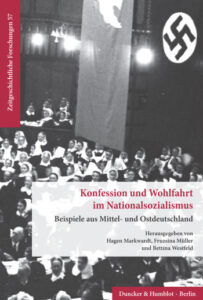 The focus on the regions of Central and Eastern Germany is a response to the current dearth of research on that region. Because denominational institutions were relatively autonomous at that time, such a regional delimitation makes perfect sense. Due to the denominational character of the region, then, most of the contributions deal with institutions and actors from the Protestant (evangelisch) spectrum, which is understandable. This will allow comparisons to be drawn between the various actors and institutions in different regions of Germany at a later point in time. It is regrettable that the editors did not succeed in soliciting contributions on the Thuringian region. They have focused on Silesia, however, which has also been rarely examined by research so far. A positive point to be emphasized here is the approach of the editors, acknowledging that the “relationship between the Christian-denominational institutions and the Nazi rule [are] not to [be understood] from the outset as dichotomous” (p. 11). Even if this approach should be a matter of course from this reviewer’s point of view, recent works show again and again that an ideological opposition between Christians and National Socialists is frequently assumed from the outset. Therefore, as self-evident as it may be, the editors’ basic attitude as it is formulated and implemented in the book is to be appreciated.
The focus on the regions of Central and Eastern Germany is a response to the current dearth of research on that region. Because denominational institutions were relatively autonomous at that time, such a regional delimitation makes perfect sense. Due to the denominational character of the region, then, most of the contributions deal with institutions and actors from the Protestant (evangelisch) spectrum, which is understandable. This will allow comparisons to be drawn between the various actors and institutions in different regions of Germany at a later point in time. It is regrettable that the editors did not succeed in soliciting contributions on the Thuringian region. They have focused on Silesia, however, which has also been rarely examined by research so far. A positive point to be emphasized here is the approach of the editors, acknowledging that the “relationship between the Christian-denominational institutions and the Nazi rule [are] not to [be understood] from the outset as dichotomous” (p. 11). Even if this approach should be a matter of course from this reviewer’s point of view, recent works show again and again that an ideological opposition between Christians and National Socialists is frequently assumed from the outset. Therefore, as self-evident as it may be, the editors’ basic attitude as it is formulated and implemented in the book is to be appreciated.
In the first, very well-structured article, Norbert Friedrich examines the developments within the Kaiserwerther Verband (KWV) in the ‘Third Reich.’ The KWV was the umbrella organization of the German deaconess mother houses. The head of the KVW is at the center of Friedrich’s examination. The KWV, to which around 30,000 deaconesses were subordinate in 1936, quickly introduced self-enforced conformity with National Socialist policies in 1933 without government coercion. In the same year, the national-conservative and anti-democratic executive committee accordingly abolished the democratic structures remaining from the times of the Weimar Republic, which were not popular anyway. By the end of March 1933, antisemitic propaganda from the National Socialists was also being echoed by the KWV. During the same year, the leadership of the association also clearly positioned itself in favor of German Christian Movement, which illustrates anti-democratic and antisemitic thinking. Due to the increasingly strong position of the Thuringian German Christians, the association distanced itself from the German-Christian spectrum from 1934 onwards, but this should not obscure its support for the Hitler state. Even if the state increasingly tried to restrict the deaconry in its actions, the KVW remained an important point of contact over the years.
In his contribution, Uwe Kaminsky analyzes the Expert Committee for Eugenics of the Inner Mission (“Fachausschuss für Eugenik der Inneren Mission”), which was founded in 1931. He concentrates on the Saxon representatives of the committee – those tasked by the regional church to discuss eugenics and euthanasia. That discourse was not without consequences, as Kaminsky rightly states, in reference to the approximately 25,000 Saxon victims of eugenics policies during the period from 1933 onwards. In the essay, Kaminsky presents biographical analyses of the individual Saxon representatives and concludes that many who had previously advocated voluntary sterilization went on to support the compulsory sterilization enforced by the National Socialists in 1933. Nevertheless, even though they agreed to the plans of the new authorities for mass sterilization, the representatives rejected euthanasia.
The Regional Association of Saxony of the Inner Mission is the focus of Bettina Westfeld’s contribution. Particularly shocking is the fact that in 1931 three of five clergymen in this regional association were members of the NSDAP. It is therefore not surprising that, immediately after Hitler came to power, the Inner Mission made declarations of loyalty to the new regime throughout Germany. Even before 1933, there was an endorsement of sterilization measures in the Regional Association of Saxony, citing as the reason for such measures the cost of care for mentally and physically handicapped people. In the years that followed, the Regional Association found itself in a field of tension within the divided Saxon regional church, which certainly did not make it easier for them to act. Westfeld’s contribution is shocking in some places, as she repeatedly refers to the number of victims and the individual fates of victims of the Nazi terror. She also addresses the attempt by individual deaconesses to hide patients to prevent them from being transported to killing centers like Pirna-Sonnenstein. However, these were individual actions and not measures by the regional church and the Inner Mission, which were hardly able to act anyway. The positive attitude towards sterilization measures also weakened the arguments of the Inner Mission to act against further measures aimed at “racial hygiene.” In the end, there was the terrifying number of 432 deaths from the homes of the Inner Mission, as well as a still unknown number of deaths of people over whom the Inner Mission held guardianship.
Christoph Hanzig examines another important aspect of this history, namely, that most of the facilities for the care of handicapped people in Saxony were not church-owned, but state-sponsored. Accordingly, Hanzig offers biographical information about the Protestant pastors in those state care facilities, in which pastors functioned as state officials. None of the pastors portrayed in detail belonged to a democratic party before 1933, but some were members of the NSDAP. So, it is hardly surprising that from 1933 almost all those pastors were actively involved in the Nazi state, supporting Nazi health policy.
The six contributions by Jan Brademann, Annett Büttner, Fruzsina Müller, Helmut Bräutigam, Manja Krausche and Elena Marie Elisabeth Kiesel all deal with empirical studies on one or more deaconess houses in Saxony or Saxony-Anhalt. For example, Kiesel examines the internal correspondence between headmasters and the sisterhood, using the case of the houses in Halberstadt, Magdeburg, and Halle/S and focusing on the “Schwesternbriefe” as a primary source. These were private in nature, which is why they offer an exclusive insight into the actual correspondence between the various staffing levels. As can be seen in the other contributions, the superiors of the houses examined by Kiesel also endorsed the appointment of Hitler as Reich Chancellor and called on the sisterhood to participate in “building up the Volksgemeinschaft.” Despite the increasing pressure from the National Socialist People’s Welfare (NSV), loyalty to the state was never in question. In 1940, an antisemitic appeal was issued to fight the Jews on the home front as well. The persecution of the Jews and the practice of euthanasia were almost never mentioned. Only in 1943 does a change in the content of the letters become visible, in which the previously loyal position to the regime was given up in favor of a stronger orientation toward peace.
Maik Schmerbauch provides a study on nursing and welfare for the poor in Breslau, while Jürgen Nitsche and Hagen Markwardt examine Jewish care facilities. Nitsche’s contribution illustrates the pressure that Jewish communities faced beginning in 1933. Increasingly deprived of infrastructure and government grants, they had to try on their own to organize care for older and handicapped community members. Accordingly, the Jewish community in Chemnitz, which serves as an empirical example, was forced to build a rest home.
Even though the regional focus is on Saxony and Saxony-Anhalt, the knowledge gained through the anthology is expansive. The respective contributions impress with their empirical depth, so that the reader gets an insight into the connection between welfare and church denomination during the time of National Socialism, from the level of regional associations down to the very local level. However, the anthology deserves a summarizing conclusion. The individual contributions are highly informative and contain many new findings. A summary by the editors would have made it possible to systematically analyze the empirical contributions again, articulate special features and point out new research perspectives. Unfortunately, the editors missed this opportunity to broaden the perspective. Nevertheless, the anthology generates a multitude of new findings regarding the role of welfare institutions under religious sponsorship during the period of the ‘Third Reich.’
 Another aunt, on the other hand, talks incessantly about the damnation that awaits Hirneise because of her turning away from God. For this aunt, there is no reality outside of faith, which is why she constantly asks God for forgiveness for Hirneise and her mother. This aunt’s husband is also strictly religious, but unlike his wife, he accepts scientific views to explain the world. For example, he sees the creation of the universe through the Big Bang as entirely possible. And he also accepts that people turn away from God, a stance that his own wife acknowledges with incomprehension. Hirneise’s mother, for her part, reports how her own mother (Hirneise’s grandmother with dementia) had demanded that her daughter remain completely abstinent until her husband—who, it should be noted, had left her—came back to her. The subject of the divorce is not discussed further, so it remains unclear why Hirneise’s father left the family. And of course, he never came back.
Another aunt, on the other hand, talks incessantly about the damnation that awaits Hirneise because of her turning away from God. For this aunt, there is no reality outside of faith, which is why she constantly asks God for forgiveness for Hirneise and her mother. This aunt’s husband is also strictly religious, but unlike his wife, he accepts scientific views to explain the world. For example, he sees the creation of the universe through the Big Bang as entirely possible. And he also accepts that people turn away from God, a stance that his own wife acknowledges with incomprehension. Hirneise’s mother, for her part, reports how her own mother (Hirneise’s grandmother with dementia) had demanded that her daughter remain completely abstinent until her husband—who, it should be noted, had left her—came back to her. The subject of the divorce is not discussed further, so it remains unclear why Hirneise’s father left the family. And of course, he never came back.
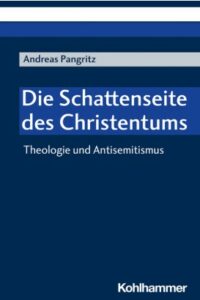 In the second chapter, Pangritz addresses the problematic distinction between the terms anti-Judaism and antisemitism. He shows that the distinction between a theologically-argued hostility towards Jews and a racially argued antisemitism, which has been repeatedly postulated since the end of the Second World War, has not stood the test of time. On the contrary, such a distinction harbors the danger that (Christian) hatred of Jews is trivialized by juxtaposing it with antisemitism. Pangritz proposes “not to speak of a break, but rather of a transformation of the traditional Christian ‘doctrine of contempt’ (Lehre der Verachtung) into the modern forms of antisemitism” (35). It remains unclear, however, why Pangritz returns to the concept of anti-Judaism later in the book (e.g. 119). The term has been overused by Christian apologetics, and Pangritz himself has pointed out that the academic distinction between anti-Judaism and antisemitism has not produced any new insights or meaningful differentiations. (30). Conceptual clarity would have been helpful here, especially since Pangritz argues well with Léon Poliakov, Peter Schäfer and even Reinhard Rürup that “antisemitism” should be used in its most general sense: “The word ‘antisemitism’ denotes hostility, hatred and contempt of all kinds against Jews and Judaism; this does not exclude differences in motivation, but includes them” (33). However, this small point is the only criticism I can make in the entire book.
In the second chapter, Pangritz addresses the problematic distinction between the terms anti-Judaism and antisemitism. He shows that the distinction between a theologically-argued hostility towards Jews and a racially argued antisemitism, which has been repeatedly postulated since the end of the Second World War, has not stood the test of time. On the contrary, such a distinction harbors the danger that (Christian) hatred of Jews is trivialized by juxtaposing it with antisemitism. Pangritz proposes “not to speak of a break, but rather of a transformation of the traditional Christian ‘doctrine of contempt’ (Lehre der Verachtung) into the modern forms of antisemitism” (35). It remains unclear, however, why Pangritz returns to the concept of anti-Judaism later in the book (e.g. 119). The term has been overused by Christian apologetics, and Pangritz himself has pointed out that the academic distinction between anti-Judaism and antisemitism has not produced any new insights or meaningful differentiations. (30). Conceptual clarity would have been helpful here, especially since Pangritz argues well with Léon Poliakov, Peter Schäfer and even Reinhard Rürup that “antisemitism” should be used in its most general sense: “The word ‘antisemitism’ denotes hostility, hatred and contempt of all kinds against Jews and Judaism; this does not exclude differences in motivation, but includes them” (33). However, this small point is the only criticism I can make in the entire book.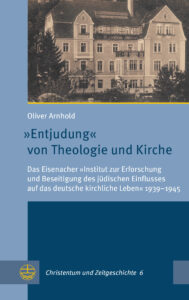 Ten years later, Arnhold has published a condensed version of his doctoral thesis. In 245 pages, he tells the history of the establishment of the largest research institute in the Third Reich that dealt with the so-called “Jewish question”. Promoted by the Thuringian German Christian Church Movement (Kirchenbewegung Deutsche Christen), the institute was opened at Wartburg Castle in Eisenach – one of the most important places for Protestants –in May 1939 with the intention of tracing and eliminating all Jewish influences within (Protestant) Christianity. The aim was to prove – on its own initiative, without state influence, supported by various Protestant regional churches and with the collaboration of renowned professors – that Jesus of Nazareth, and with him Christianity as a whole, had always stood in extreme contrast to Judaism. Jews, however, had distorted the true message of Jesus, which the Eisenach Institute was to bring to light again. Accordingly, some of the staff also saw themselves as completing Luther’s Reformation. Luther had liberated Christianity from the papacy in the sixteenth century. Now, under the rule of the “God-sent Führer” Adolf Hitler, the time had come to accomplish in full Luther’s Reformation and remove all alleged Jewish influences from Christianity. The message of Jesus and, indeed, his entire person were to be “de-Judaized” (entjudet) – nothing more and nothing less.
Ten years later, Arnhold has published a condensed version of his doctoral thesis. In 245 pages, he tells the history of the establishment of the largest research institute in the Third Reich that dealt with the so-called “Jewish question”. Promoted by the Thuringian German Christian Church Movement (Kirchenbewegung Deutsche Christen), the institute was opened at Wartburg Castle in Eisenach – one of the most important places for Protestants –in May 1939 with the intention of tracing and eliminating all Jewish influences within (Protestant) Christianity. The aim was to prove – on its own initiative, without state influence, supported by various Protestant regional churches and with the collaboration of renowned professors – that Jesus of Nazareth, and with him Christianity as a whole, had always stood in extreme contrast to Judaism. Jews, however, had distorted the true message of Jesus, which the Eisenach Institute was to bring to light again. Accordingly, some of the staff also saw themselves as completing Luther’s Reformation. Luther had liberated Christianity from the papacy in the sixteenth century. Now, under the rule of the “God-sent Führer” Adolf Hitler, the time had come to accomplish in full Luther’s Reformation and remove all alleged Jewish influences from Christianity. The message of Jesus and, indeed, his entire person were to be “de-Judaized” (entjudet) – nothing more and nothing less.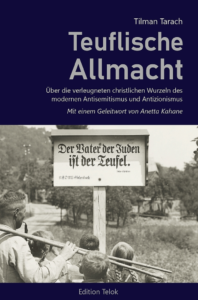 First, Tarach uses National Socialist propaganda for his analysis and demonstrates that many Nazi stereotypes came directly from the Christian context: the Jews as children of the devil, the betrayal by Judas Iscariot, etc. In the middle of the twentieth century, those images were well known by Christian people. The murder of Jesus of Nazareth remains the central element of Christian anti-Semitism up to modern anti-Semitism and forms the background of all persecutions of the Jews. Even today, in parts of Eastern Europe, the Jew is symbolically burned at Easter because he murdered Christ. We fully agree with the author’s statement that the New Testament already spread the first anti-Semitic conspiracy theory: the Jew as murderer of God (48). The desire for the annihilation of all Jews, which was already virulent before National Socialism, is based precisely on this motive: a danger emanates from the Jews. That is why the extermination of the Jews is also seen as self-defense. At this point, the author could, or even should, have referred to the minutes of the Wannsee Conference to support his arguments. In it, the motivation for the extermination of the Jews in Europe by the National Socialists as an act of self-defense is particularly clearly expressed.
First, Tarach uses National Socialist propaganda for his analysis and demonstrates that many Nazi stereotypes came directly from the Christian context: the Jews as children of the devil, the betrayal by Judas Iscariot, etc. In the middle of the twentieth century, those images were well known by Christian people. The murder of Jesus of Nazareth remains the central element of Christian anti-Semitism up to modern anti-Semitism and forms the background of all persecutions of the Jews. Even today, in parts of Eastern Europe, the Jew is symbolically burned at Easter because he murdered Christ. We fully agree with the author’s statement that the New Testament already spread the first anti-Semitic conspiracy theory: the Jew as murderer of God (48). The desire for the annihilation of all Jews, which was already virulent before National Socialism, is based precisely on this motive: a danger emanates from the Jews. That is why the extermination of the Jews is also seen as self-defense. At this point, the author could, or even should, have referred to the minutes of the Wannsee Conference to support his arguments. In it, the motivation for the extermination of the Jews in Europe by the National Socialists as an act of self-defense is particularly clearly expressed.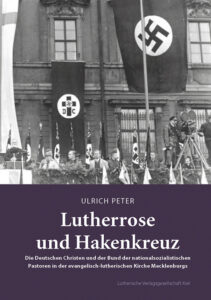 Above all, the work on the Thuringian German Christians, the dominant German-Christian movement in the “Third Reich” up to 1945 (Clemens Vollnhals), clearly shows how a large number of evangelical pastors–also far beyond Thuringia–dealt with National Socialism, perceiving it as connected to or at least instrumental in helping to build a “new Germany.” It is particularly striking, however, how many pastors–here again, beyond the Thuringian German Christians–welcomed the anti-Semitism of the National Socialists and even justified it theologically.
Above all, the work on the Thuringian German Christians, the dominant German-Christian movement in the “Third Reich” up to 1945 (Clemens Vollnhals), clearly shows how a large number of evangelical pastors–also far beyond Thuringia–dealt with National Socialism, perceiving it as connected to or at least instrumental in helping to build a “new Germany.” It is particularly striking, however, how many pastors–here again, beyond the Thuringian German Christians–welcomed the anti-Semitism of the National Socialists and even justified it theologically. The introduction lasts the first seventy pages, and not until almost halfway through the volume does the discussion focus on Nell-Breuning. The previous pages explained the state of Christian solidarity in the 1920’s, describing Nell-Breuning’s definition of the term as post-liberal corporatist solidarity, but not fascist or reactionary. Hagedorn explains in detail the distinctions between the more romanticist-idealist Catholic thinkers in Vienna and the northern German approach to Catholic solidarity, which better reflected the economic realities of the 1920’s. Nell-Breuning was more comfortable with the “Kölner Richtlinien” of 1926, which explicitly accepted Catholic trade unions and much else in Catholic social teaching that would integrate Catholics in the broader economic and labor concerns of the times. For example, the Austrians denied any compatibility between capitalism and Christianity. At the same time, the commission established by Cardinal Schulte, Archbishop of Cologne, sought to find a way for Catholics, employers, employees, and others to function in the Weimar Republic’s economic conditions. Nell-Breuning also advocated ecclesiastical recognition of Christian trade unions and not just Catholic workers’ associations (katholische Arbeitervereine) led by priests.
The introduction lasts the first seventy pages, and not until almost halfway through the volume does the discussion focus on Nell-Breuning. The previous pages explained the state of Christian solidarity in the 1920’s, describing Nell-Breuning’s definition of the term as post-liberal corporatist solidarity, but not fascist or reactionary. Hagedorn explains in detail the distinctions between the more romanticist-idealist Catholic thinkers in Vienna and the northern German approach to Catholic solidarity, which better reflected the economic realities of the 1920’s. Nell-Breuning was more comfortable with the “Kölner Richtlinien” of 1926, which explicitly accepted Catholic trade unions and much else in Catholic social teaching that would integrate Catholics in the broader economic and labor concerns of the times. For example, the Austrians denied any compatibility between capitalism and Christianity. At the same time, the commission established by Cardinal Schulte, Archbishop of Cologne, sought to find a way for Catholics, employers, employees, and others to function in the Weimar Republic’s economic conditions. Nell-Breuning also advocated ecclesiastical recognition of Christian trade unions and not just Catholic workers’ associations (katholische Arbeitervereine) led by priests. The focus on the regions of Central and Eastern Germany is a response to the current dearth of research on that region. Because denominational institutions were relatively autonomous at that time, such a regional delimitation makes perfect sense. Due to the denominational character of the region, then, most of the contributions deal with institutions and actors from the Protestant (evangelisch) spectrum, which is understandable. This will allow comparisons to be drawn between the various actors and institutions in different regions of Germany at a later point in time. It is regrettable that the editors did not succeed in soliciting contributions on the Thuringian region. They have focused on Silesia, however, which has also been rarely examined by research so far. A positive point to be emphasized here is the approach of the editors, acknowledging that the “relationship between the Christian-denominational institutions and the Nazi rule [are] not to [be understood] from the outset as dichotomous” (p. 11). Even if this approach should be a matter of course from this reviewer’s point of view, recent works show again and again that an ideological opposition between Christians and National Socialists is frequently assumed from the outset. Therefore, as self-evident as it may be, the editors’ basic attitude as it is formulated and implemented in the book is to be appreciated.
The focus on the regions of Central and Eastern Germany is a response to the current dearth of research on that region. Because denominational institutions were relatively autonomous at that time, such a regional delimitation makes perfect sense. Due to the denominational character of the region, then, most of the contributions deal with institutions and actors from the Protestant (evangelisch) spectrum, which is understandable. This will allow comparisons to be drawn between the various actors and institutions in different regions of Germany at a later point in time. It is regrettable that the editors did not succeed in soliciting contributions on the Thuringian region. They have focused on Silesia, however, which has also been rarely examined by research so far. A positive point to be emphasized here is the approach of the editors, acknowledging that the “relationship between the Christian-denominational institutions and the Nazi rule [are] not to [be understood] from the outset as dichotomous” (p. 11). Even if this approach should be a matter of course from this reviewer’s point of view, recent works show again and again that an ideological opposition between Christians and National Socialists is frequently assumed from the outset. Therefore, as self-evident as it may be, the editors’ basic attitude as it is formulated and implemented in the book is to be appreciated.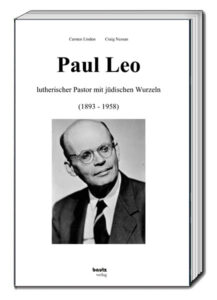 Based on extensive archival source material, Linden describes Paul Leo’s early professional career. When the National Socialists came to power, Leo faced increasing difficulties due to his Jewish ancestors. Why Linden then adopts the racial biological interpretations of the National Socialists in this regard and describes Paul Leo as the “Jewish pastor of the regional church” (p. 19) is disturbing, however. Unfortunately, Linden also makes significant mistakes in terms of content: The Confessing Church did not form due to alleged state and National Socialist (where should a dividing line be drawn here?) interventions in church affairs (p. 18). This apologetic church historiography of the 1950s has been refuted many times in recent years, which should be taken into account when dealing with such a topic.
Based on extensive archival source material, Linden describes Paul Leo’s early professional career. When the National Socialists came to power, Leo faced increasing difficulties due to his Jewish ancestors. Why Linden then adopts the racial biological interpretations of the National Socialists in this regard and describes Paul Leo as the “Jewish pastor of the regional church” (p. 19) is disturbing, however. Unfortunately, Linden also makes significant mistakes in terms of content: The Confessing Church did not form due to alleged state and National Socialist (where should a dividing line be drawn here?) interventions in church affairs (p. 18). This apologetic church historiography of the 1950s has been refuted many times in recent years, which should be taken into account when dealing with such a topic.